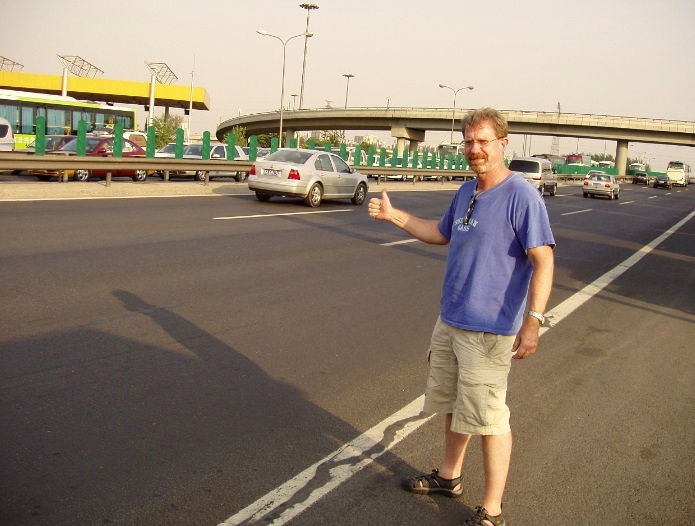3 min read
Thumping down the steps of the ancient fortress, I spotted my bank’s familiar logo and headed to the ATM. Excellent. I was running low on cash, so I crossed the street and conjured up my PIN number on the other side of the world. A fist full of $20’s later, I turned to walk back to the Great Wall of China. I didn’t make it.
Yes, the 13,000 mile wall built to keep out foreigners for 2,200 years, now shelters the ATMs of the world’s great banks. Welcome to China… Beijing Edition.
As I began to cross the street back to the Great Wall, a flurry of aggressive capitalists grabbed my arms, my shirt, my belt. Each tried to drag me to their stall filled with authentic souvenirs – suitcases, balloons, T-shirts and hats, hats, hats – all in English, all good deals.
These budding entrepreneurs can easily overwhelm a dazed westerner and I quickly succumbed. Pulling out a few of my new Citibank $20’s, I bought yet more gifts for the family back home. Anything to stop the mauling. These Chinese ladies were tough.
This international incident occurred at the Badaling section of the Great Wall, the part you usually see in early morning photos. I’m assuming early morning because the infinite lengths of wall in these photos are absent the crowds we encountered.
The Great Wall was built to keep out the hordes, but every day they invade by the hundreds of thousands, traipsing along this ancient rampart. It’s a river of bodies. I’ve never seen so many iPhones on one fortress.
The Mings
We were about 40 miles north of Beijing, the seat of the Chinese Communist Government for the last 70 years. It was also the seat of the Ming dynasty for 276 years. That’s why this section of the wall is heavily built and fortified. You didn’t want to mess with the Mings.
However, a rebel from within, Li Zicheng, did mess with the Mings. In 1644 Li and his allied army passed through the Great Wall when the gates were opened by a sympathetic general. Suddenly all 13,000 miles of wall meant nothing.
That then, is the inherent problem with walls. They just stand there. Humans, on the other hand, are mobile creatures and can find weaknesses in defenses, overwhelming them. That’s why the Great Wall failed again and again through millennia, susceptible to the Mongols, the Manchus and the Mexicans… had they wanted to.
Even my little film crew found spots in the wall where we could hide or pass through. Not that we had any plans for invasion. We were just here to document the grandeur of the 2,000 year old Wall and marvel that most tourists in China are… Chinese. Here to check out the wall with their own eyes.
Fun fact: the Great Wall wasn’t just built to stop invaders, it was also created as a border control, to stop immigration. The various Chinese dynasties didn’t want the Mongol hordes slipping in and out of their kingdom, taking their jobs and sending money orders back home.
But again, one cannot wall off human nature. The Mongols traded with the Chinese all along the border, freely entering China’s airspace as they leaped over the Wall. For most of its existence, the big barrier hardly stopped anyone but it looked great. The Chinese definitely had the biggest wall on the block.
It is said the Great Wall is the only human artifact that is so massive it can be seen from the moon. This is ironic because when the first moon landing astronauts returned to earth they were housed in a specially built, airtight trailer, in case they accidently picked up some unknown lethal microbes. This seemed like a prudent idea until one morning the astronauts noticed a stream of ants crawling into the trailer from the outside, looking for their breakfast.
So much for keeping out those in search of their next meal. So it is with walls.
Commuting – Beijing Style
From some reason our client provided my little crew and me with our own bus. Not a van, but a full-length great big bus, just for the four of us. It was old but we could stretch out.
So when it was time to say goodbye to the Great Wall we hopped on our big smoky bus and headed out on the Great Freeway of China. Traffic congestion is fairly new to China with their recent prosperity and many, if not most, drivers didn’t get to sit behind the wheel until they were in their 50’s.
This makes for two kinds of drivers – very cautious or terrifyingly clueless. More than once, when crossing a city street, I was clipped by a distracted motorist. I shouted, but who can hear you in a sea of one billion.
Anyway, we crept along the freeway in LA-like traffic, enjoying the 1950’s-style pollution when the old bus glided to a stop along the side of the road and simply died. Silent. Dead. It was like it had just been purged from a reactionary regime of Stalinist buses and airbrushed out of the motor pool.
The driver tried to potschke around with the engine but there were no signs of life. A couple of motorcycle cops came by to see what the trouble was. Me and the guys stood there in the hot Beijing afternoon, all bumper to bumper and bored.
While we waited for a new People’s bus to rescue us, I thought I’d try hitching a ride… for laughs. Hitching in China is illegal and so doing this right in front of a bunch of cops is really funny. Or not. Luckily they viewed me as some kind of wacky foreigner and even smiled… as long as I stopped.
Which I did because my phone rang. It was my ten-year-old son, crying. He was calling me from the other side of the world as I stood hitch hiking just down the street from the Great Wall. Talk about a global village. Your crying kids can now easily reach you at work… even if that work lands you on the side of a crowded Chinese freeway.
But that’s the beauty of our interconnected world. Shared feelings and ideas now travel with the ease of child’s wish. Nothing can stop the flow of our shared expectations and beliefs. This in turn renders once mighty walls into packaged tourist attractions.
I can’t remember what was bothering my son that day but I know I soothed him and told him I would be home soon. And that made us both feel much better.
So Who Did Pay For The Wall?
There’s no one answer to this. But it was a Chinese wall so in the end it was the Chinese that paid… for thousands of years. It was financed mainly through taxes starting in the Qin dynasty. The wall was so expensive it crushed their economy, sparking a rebellion.
Later, during the Han dynasty, a popular state sponsored lottery paid for great lengths of wall. There is no record of how much the winners won or if they quit their jobs and started traveling.
Perhaps those who ultimately paid for the Great Wall were the 1 million laborers who died building it. It is rumored that they are buried within the wall itself. In fact, the Wall is also known as ‘the world’s longest cemetery.’
These forced laborers had no say in the dreams of their Emperors who promised their subjects lasting security. Yet through the centuries, these Emperors and their imperial dynasties, time and again, never learned how frail a great wall really is.
Our new bus finally arrived and we got back to Beijing in time to see the coolest acrobatic show ever. I don’t know how they did it but those Chinese acrobats flew through the air, defying gravity.
It was a pretty amazing end to the day and it showed me once again, we humans can accomplish anything. We can build great walls. And then we can fly over them.
Jon Lapidese is a travel copywriter and blogger.









